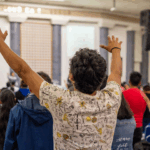Australian missionaries to Korea experienced the grace of God; they bore witness to that grace; they found grace in the hearts of the people among whom they lived. And, as their descendants have discovered, they left a lasting legacy.
On September 30 this year, a group of 21 Australian missionaries and past missionaries’ descendants, as well as 12 Korean-Australians, gathered at Incheon Airport, near Seoul, to embark on a ten-day trip in South Korea.
They were the special guests of the Gyeongnam Holy City Movement for the opening of The Memorial Hall of Gyeongnam Mission, to mark the 120th anniversary of Australian missionaries to Korea.
Presbyterian missionaries and churches have been particularly successful in Korea.
The first Presbyterian missionary, the American Horace Allen, began medical work in Korea in 1884. The next year Horace Underwood, an ordained minister, joined him.
Australian missionaries from the Presbyterian Church of Victoria, Harry and Mary Davies, began work in Korea in October 1889.
Belle Menzies, later the aunt of Sir Robert Menzies, arrived in October 1891, sponsored by the newly-formed Presbyterian Women’s Missionary Union. She was followed by Bessie Moore and Agnes Brown.
According to Australian National University archivist Maggie Shapley, their mission work consisted of holding daily meetings for worship, classes for religious instruction, providing medical aid, and organising Sunday school classes.
They also took to “itinerating” to surrounding villages, sometimes travelling hundreds of kilometres on foot or by pony, to conduct meetings in private homes.
Past connections
Australia’s Korean language Christian Review, reporting on the 120th anniversary touring party, said that although there were a few missionaries in the group — Barry and Joan Rowe, Barbara Martin and Marjorie Neil — the vast majority were the descendants of past missionaries.
Every member of the group reconnected with their past: they visited the areas where their ancestors had lived and worked, worshipped in churches their forebears had started, paid respects at the gravestones of their family members and delighted in seeing their old photographs and relics displayed in museums.
The itinerary included trips to churches, schools, cemeteries, hospitals, museums and memorial halls in Busan, Masan, Changwon and Seoul.
All sites had significance to the group as they were either places the Australian missionaries had established or where they’d made great contributions.
Alison and Douglas Robertson from Scots Church, Melbourne, went as representatives of Davies, who spent five months in Korea studying the language, then spent 20 days walking to the Busan area, where he was planning to work.
He got smallpox and pneumonia on that journey and died the day after he arrived, aged 33.
The Robertsons said, “Many of our visits were fairly emotional as we saw the fruits of the labours of the ancestors of our group. It was wonderful to see thriving churches, and hospitals and schools serving the needs of the community and continuing the mission of taking the gospel to the lost and needy.”
Barry and Joan Rowe, who lived in Korea from the mid-1960s to mid-1970s, commented on the legacy the early missionaries left to the Korean people, in their setting up of Christian churches, schools and health facilities. “But the Koreans did not stand still and leave these beginnings as only beginnings — they have continued and enlarged on the work begun so long ago, from generation to generation.”
Michael Brown, son of John and Norma Brown, missionaries from 1960 to 1972, reflected that mission work was not at all easy in a foreign country with a different language in an era allowing little communication with one’s home country.
“In addition to the sharing of the Christian message by word, earlier mission work filled gaps in social services, health and education that we would now expect modern governments to fill.
“I was deeply moved when reminded of the wonderful work done by Australian missionaries and their Korean associates with people suffering from leprosy and disabilities, as well as with children and women. It is encouraging to see the modern Korean church turning its focus to other countries facing challenges of poverty, disease and war-related trauma.
“And finally, it is amazingly faithful, dedicated and industrious Korean people who have grown the Korean church into its astonishing state today. Continuing faithfulness to Jesus’ message of compassion should sustain the growing mission of the Korean church well into the future.”
John Brown’s 2009 book Witnessing Grace, published by the Presbyterian Church of Korea, records brief profiles of 126 missionaries sent by the Presbyterian Church and the Uniting Church in Australia to bear witness to the gospel of Jesus Christ in word and service in Korea during the past 120 years.
He writes, “The response they received was above all one of gratitude and welcome, which overlooked any lack of cultural respect and incongruence. The lingering feeling in the hearts of the missionaries was, ‘We gave so little; we received so much.’”
There are over 100 Reformed and Presbyterian denominations in South Korea and over 28 per cent of the population identifies itself as Christian. Korean Presbyterians now send missionaries to Europe and the United States.
Copies of Witnessing Grace are available from Uniting World (for $25 if collected) or from John Brown, 6251 0391, for $35 (including postage). See “Reflections of the Australian missionaries and their descendants” at https://christianreview.com.au/.











